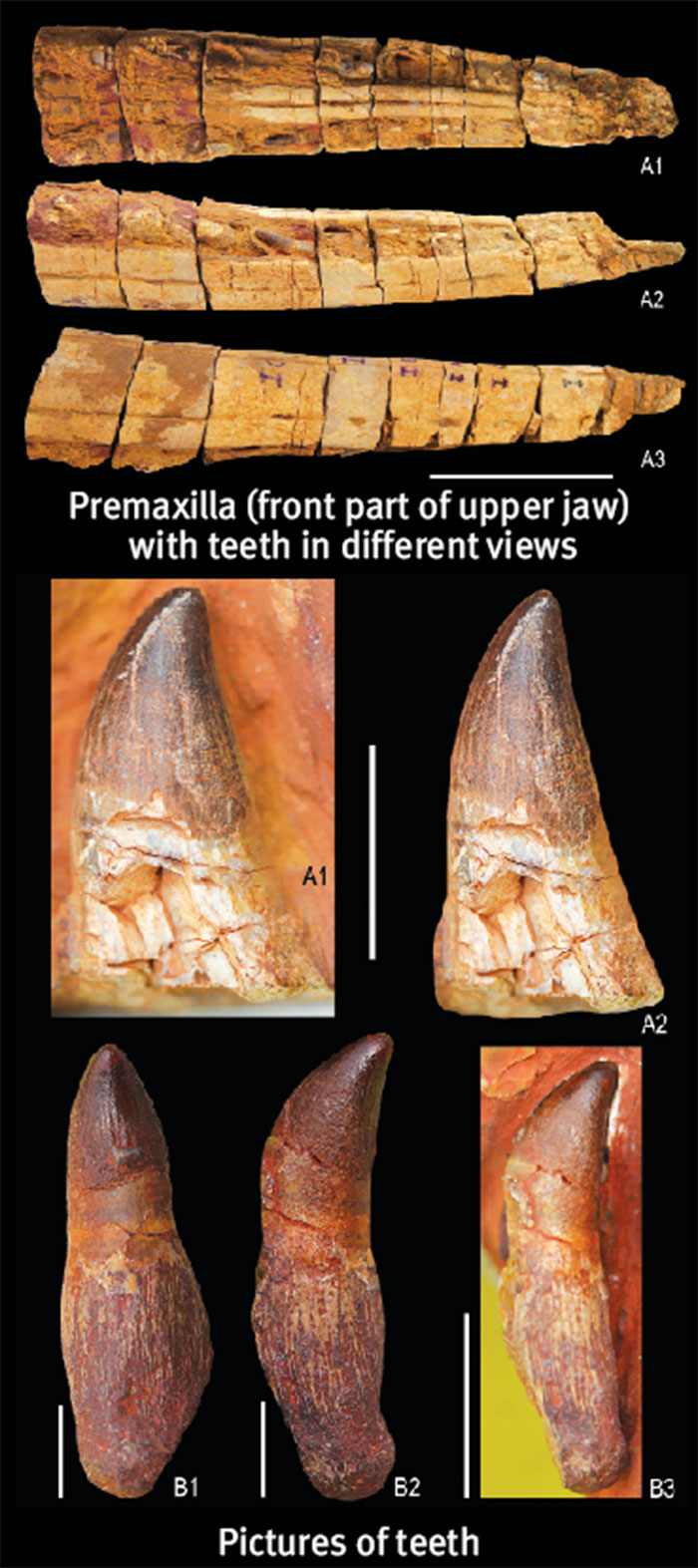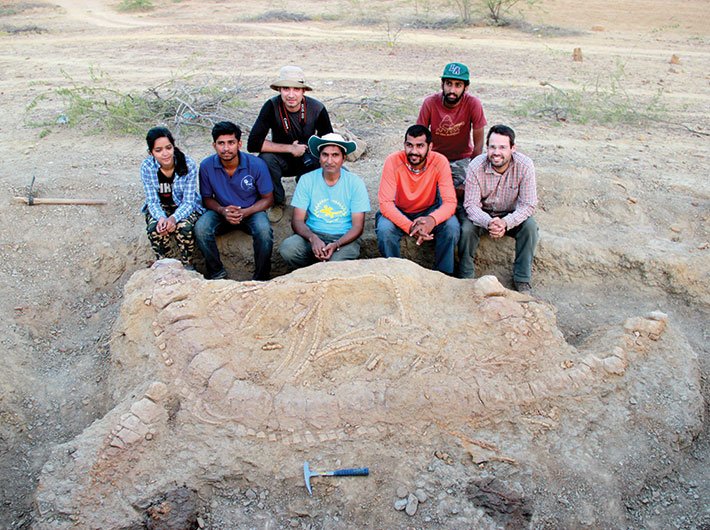The fossil of the ichthyosaurus, the first found in India, tells the story of a time when sea flowed over modern-day Kutch in Gujarat
If only fossils could talk. When a team of researchers recently unearthed a gigantic fossil of a sea creature that lived millions of years ago in Kutch, they took us back in time to when there were just two continents in the whole world – Gondwanaland and Laurasia, with India being part of the former, stuck to Africa, South America and Australia.
Those were the ages when dinosaurs ruled the land, gigantic ichthyosaurs created terror in the seas and strange huge winged creatures like the Pterodactyl reigned in the skies.
This was in the Mesozoic era, which includes the Jurassic age and dates back to 250 to 90 million years. Just 30 million years later, the earth had begun to look similar to what it is now, with similar kind of flora and fauna, the mammoths having perished mysteriously, perhaps due to a meteor fall.
The fossil of the ichthyosaurus, the first ever found in India, tells the story of a time when the sea flowed over modern-day Kutch and was the hunting ground of these huge creatures, which preyed on other smaller sea creatures.
A team of paleontologists led by Guntupalli Prasad of Delhi University (see interview) found the fossil in Kutch.
The sea monster had an appearance that is a mix of a lizard and a fish. Its fossilised remains have been found in different parts of the earth but never in India. Prasad says that isolated bones and teeth have been found in the Cauvery basin in the past but a whole fossil has never been found.
Gujarat, which also happens to be the site where a large number of dinosaur eggs were sighted a few years ago, has now sparked hopes for more fossil finds of ichthyosaurs elsewhere in India.
The fossil they found was 5.5 metres long. According to Prasad, this animal most likely ate shelled marine animals known as ammonites and other crunchy marine creatures.
What caused surprise to the team was the fact that the fossil was found almost whole despite the animal being a massive vertebrate.
He said their presence here suggests that they may have moved between Europe, western India, Madagascar and South America till they all disappeared along with other mammoths. Prasad says that there was a lot of excitement among paleontologists about the discovery. “They were excited at this new finding as no ichthyosaur fossils were found in India previously,” says Prasad.
He quotes Steve Brusatte, a paleontologist at the University of Edinburgh: “This new skeleton has the potential to reveal many secrets about ichthyosaur evolution and biogeography.”
Prasad’s mentor and well known vertebrate palaeontologist Ashok Sahni, known for finding India’s dinosaur fossil as well as unearthing dinosaur eggs about three decades ago, says that it is a great discovery.
“The search is never over. You always expect something to come. That is why it is so exciting. I’m pretty sure there will be many more in India if more people looked,’’ he says.

Interview: Guntupalli Prasad, head, department of geology, Delhi University
Since this fossil dates back to the time when what’s now India was united with some other present continents, does it mean that this part of India was under the sea?
The fossil was preserved in late Jurassic rocks (152 million years). India was part of the former southern supercontinent Gondwanaland, which comprised South America, Africa, Antarctica, Australia, India and Madagascar. The northern continents were assembled into the supercontinent Laurasia (North America, Europe and Asia). These two supercontinents were separated by an east-west trending equatorial sea known as Tethys. By the end of the Jurassic era (by the time the ichthyosaur fossil was buried), the southern supercontinent Gondwanaland started breaking up, forming a seaway between Africa and India, which had extended further southwards separating Antarctica and South America and this seaway was connected to the Tethys sea in the north. This seaway is known as Indo-Madagascan Seaway or Trans-Gondwanan Seaway. Yes, Kutch, in Gujarat, where the fossil was found, and Jaisalmer region in Rajasthan were under sea at that time.
Did these creatures exist when we had a single continent or they were there when the drift had started and Pangea had begun to split in three?
Yes, the ichthyosaur was living at a time the supercontinent started to break up.
Is it true that about 4,000 ichthyosaur fossils have been found so far? Do these pieces fall in place and say something now?
Yes, there are more than 4,000 ichthyosaur species at present, mostly from England, Germany, France, Russia, Norway, Canada and North America. Some fossils are also known from Australia and South America. Because of these specimens, some of which are exceptionally preserved, particularly those from England and Germany, we could learn a lot about their lifestyle, reproduction, function and dietary habits. For example, some of the specimens from early Jurassic of Germany showing young ones being delivered from the mother indicated that ichthyosaurs are viviparous (bore live young) rather than laying eggs as is the practice in other reptiles.
Is it right to believe that these were some kind of sea monsters? Since they are called fish-lizards, did they also live on land?
They are not monsters. These were huge animals like dinosaurs on the land many reaching a size of 16 to 20 metres in length. The term is generally used in the popular press to denote their large size and ferocious jaws with a battery of large conical teeth adapted for carnivorous diet.
They did not live on land. Their limbs were modified for swimming and were not suited to walking on land. The term fish-lizard refers to their similarity to fishes in having a streamlined body and the term lizard refers to their reptilian lineage.
Are there other places in India where such fossils can be found? What are your future plans on this matter?
Since these reptiles lived in marine seas we expect to find them in marine sedimentary rocks. Marine Jurassic rocks occur in Kutch and Jaisalmer region of peninsular India and the Spiti region of the Himalayas. We plan to carry out detailed exploratory work in these regions beginning with Kutch to find more such specimens.
Was there any hint of ichthyosaur remains in the past in India?
This is definitely the first Jurassic ichthyosaur from India. Ichthyosaurs remains such as isolated teeth and poorly preserved vertebrae have been reported from the early Cretaceous rocks of Cauvery basin, but no in-situ skeleton was found. Moreover, the Cretaceous record comes from rocks 50 million years younger than the Kutch find.
feedback@governancenow.com

